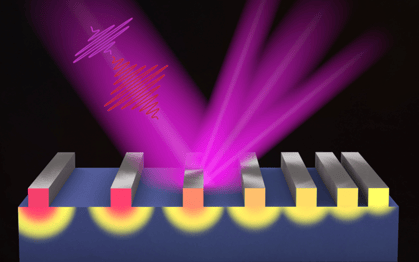Heat transport is driven by a thermal gradient, flowing from hot to cold regions in a material. However, at dimensions < 100 nm, bulk models no longer accurately predict the transport properties of materials. Because no complete models of nanoscale heat transport were available, many researchers assumed instead that bulk-like diffusive heat transport was valid – provided that an effective parameter, such as a size-dependent thermal conductivity, was incorporated. Such a simple model makes it challenging to implement smart predictive designs for thermal management in nanodevices. This lack of understanding precluded technological progress to push clock speed beyond terahertz frequencies due to heat accumulation in devices.
In exciting recent research, the exquisite sensitivity of dynamic EUV scatterometry was used to better capture nanoscale heat flow, with about picometer precision. This sensitivity made it possible to observe, generalize, and understand a surprising experimental finding - an array of closely-spaced nanoscale heat sources can cool more quickly than when spaced far apart, due to better coupling to the phonon spectrum in the substrate. Researchers are exploring a broad range of materials and structures to map out this unexpected behavior, first in 1D and now in 2D nanostructures – where in 2D, these effects are even larger. Moreover, using these comprehensive data sets, better predictive theories for nanoscale thermal management are being developed – from atomistic to hydrodynamic. These more advanced theories can replace previous phenomenological models that require the use of geometry-dependent fitting parameters, and can also explain from a fundamental perspective how and why nanoscale heat transport is different. It was recently found that cooling of 1D and 2D nanoscale hot spots can be far better described if a new and general hydrodynamic heat transport regime is also incorporated. These new EUV metrologies can guide the design of energy-efficient nano and quantum devices, where better thermal management is critically needed.
Related Publications

New regimes of nanoscale heat flow. Counterintuitively, closely-spaced nanoscale heat sources can cool more quickly than when spaced far apart, due to better coupling to the phonon spectrum in the substrate.
© Copyright 2018-2024 KMLABS leading in ultrafast All Reserved | Privacy Policy